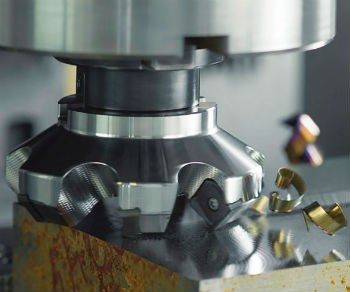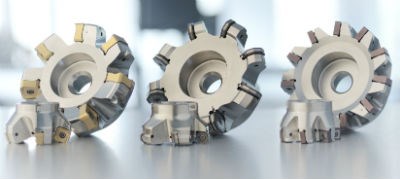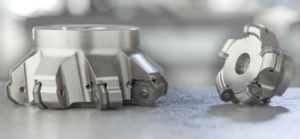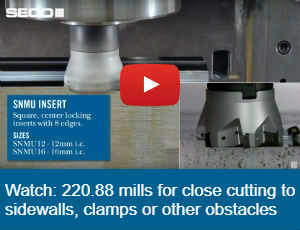Three Face Milling Myths & Truths
Sponsored ContentNew face mill designs let you get the most out of today's more powerful machining centers. If you haven't already, it's time to re-examine your assumptions on face milling operations.
Share

It’s easy to assume that not much has changed with face mills for a while. There’s been so much attention on other milling processes over the last few years, and face mills, or shell mills, were pretty efficient already. But as machining centers have become more capable, and powerful, opportunities have opened to substantially improve the productivity of this venerable process. And new face mill designs have emerged that are up to the challenge. So here is an opportunity to rethink some assumptions you may have on what’s possible to improve your face milling operations.
Watch this Double Quattromill 22 face mill machine P5 tool steel at a feed rate of 25.7 ipm and 0.196" depth of cut.
Myth: The machines are changing but the face mills stay the same.
Truth: New machines require face mills that can keep up.
Almost every machine shop uses face mills for roughing, semi-finishing and finishing, but many of these shops miss out on increased material removal rates (MRRs) because they run yesterday’s tooling on today’s machine tools. The larger spindle tapers and higher horsepower ratings, feeds and speeds of modern machines need to run with the latest in face milling cutter and insert technology to maximize a machine’s face milling potential. That’s how shops speed up production, increase efficiency and reduce cost per part, especially on larger workpieces.

Double Quatrolmill 22 face mills are designed to make full use of your machine’s power with aggressive roughing operations at large depths of cut. Learn More.
The latest face milling cutters incorporate a new generation of multi-sided, multi-edged insert options that help optimize current machine tool performance with their free-cutting capabilities. These insert geometries increase tool life, reduce cutting forces and produce chips with the open formation that reduces cutting edge stress.
Face milling cutters like Seco’s ®Double Quattromill, ™Double Octomill and R220.88 take these new insert geometries and apply them with advanced cutter designs, including such features as optional insert cassette versions and differential pitch design for attaining the highest surface finish quality or optimized cutter geometries with negative axial and radial rake angles designed for the highest productivity with the most favorable cutting forces. Between new insert geometries like ME12 or M10 and innovative cutter body designs, the next generation of face mills makes it easier than ever to get the most out of advanced machine tool technology.
See this Double Octomill face mill cut P5 tool steel at a feed rate of 43.3 ipm and a 0.157” depth of cut.
Myth: Trial and error is the only way to get a milling process right.
Truth: The truth about your process can be found on your inserts’ edge.
When it comes to developing a new milling process or working to optimize an old one, trial and error can be a vital tool – after all, experimentation is the most scientific way to solve a problem. And in many cases, obtaining the perfect cutting parameters and longest tool life requires a fair bit of playing around with variables and seeing what happens. But before you start test cutting, consider that your milling inserts can tell you everything you need to know, as long as you look closely enough.

With double-sided inserts totaling 16 cutting edges, Double Octomill face mills combines performance with economy. Learn More.
Examining insert wear and failure modes can be critical when optimizing processes. Everything that happens to an insert happens for well-understood reasons. Comb cracks, for example, are a tell-tale sign of thermal stress, while built-up edges develop when workpiece materials are welded to the insert via pressure. By putting your inserts under a microscope and checking wear as it develops, you can arrive at the correct process far more quickly than through trial and error alone. To learn more, see the troubleshooting section of the Seco Milling Navigator.
Watch this Seco R220.88 face mill take cuts of P5 tool steel at a 48 ipm feed at 0.236 DOC, and 41 ipm feed at 0.472 DOC.
Myth: Milling is complicated and requires experts.
Truth: More variables doesn’t mean more complication.

Seco R220.88 face mills with near 90-degree inserts provide the ability to machine close to sidewalls, fixture clamps or other obstacles. Learn More.
Milling does involve far more factors than the average turning operation, and many manufacturers have come to believe that only a master of milling can balance these factors and find the best possible solution for a given milling challenge. While it’s certainly true that a milling expert is a fantastic addition to any shop’s team of machinists, extensive expertise is not required for successful milling. Because of the wide variety of factors involved in a given milling application, some milling specialists believe that it’s actually much easier to handle, as more variables to play with means more opportunities to find a near-optimal solution for a given issue.
Furthermore, manufacturers aren’t working in a vacuum. With a tooling supplier like Seco, shops start with baseline cutting parameters and application strategies proved out by in-house experts. And when those parameters need to be adjusted to meet your unique application needs, you can rely on these same experts to assist with finding the ideal insert and cutter combination to obtain the optimal cutting strategy.
Go here for more information on Seco face mills.


